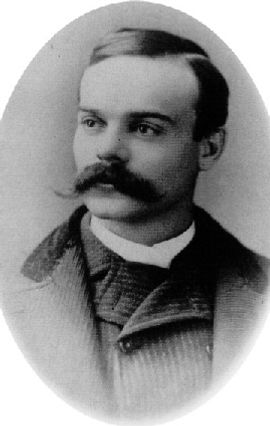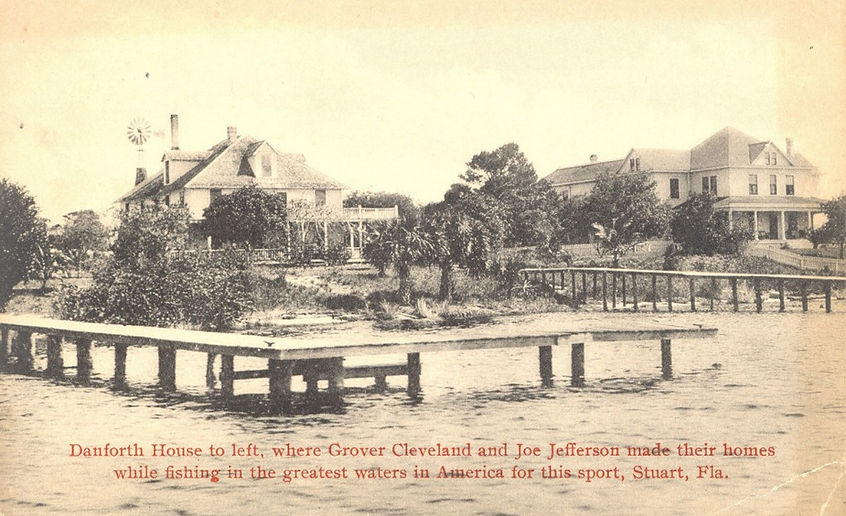PBSCV1599

Gen. James Patton Anderson Camp 1599
Celebrating 34 Years 1992 - 2026
STUART, FLORIDA


A Condensed History of Stuart, Florida
From a Book By Sandra Henderson Thurlow
The Atlantic Ocean, the Indian River, the North and South Forks of the St. Lucie River, and countless creeks played major roles in the history of Martin County. Inhabitants depended on the bounty of the water, as did the pioneers who settled here in the late 1800s.
The Gulf Steam is a shipping lane just off our coast. In 1876, before the region was settled, the U. S. Government built Gilbert’s Bar House of Refuge on Hutchinson Island. A keeper and his family offered assistance to victims of shipwrecks.
In the 1880s, Homer Hine Stuart, Jr. purchased property and built a bungalow on the north side of the St. Lucie River. He donated land for a depot and in return his surname name was given to the railway stop after Henry Flagler brought his railway down the Florida east coast to Palm Beach. There was no vehicular bridge across the St. Lucie River at that time
When, general store owner Walter Kitching convinced Flagler officials to move the depot to a site in front of his store, the name Stuart came to the south side of the river with the depot.
With the arrival of the Florida East Coast Railway, pioneer life changed dramatically. Reliable transportation made it much easier to ship fish and pineapples, the region’s major products. The tourist industry blossomed and social life revolved around the arrival of trains that now brought the mail.
After the Stuart railway depot was moved to the south side of the St Lucie River, passenger and freight depots, railway spurs, boat docks and a ferry landing formed the hub of pioneer Stuart. Today, Stuart’s Flagler Park is in the location of the community’s former commercial center. The only vestige that remains is the former General Merchandise Store, today’s Stuart Heritage Museum.
Our first tourists were outdoorsmen who came to hunt and fish. Maine hunting guide, John Danforth brought a houseboat down to serve as the first hotel, then later built the Danforth Hotel. The Stuart House, another hotel, evolved from Broster Kitching’s first combination post office and store.
Former President Grover Cleveland discovered the region’s good fishing and stayed at the Danforth Hotel. The news of Stuart’s fabulous fishing spread and other hotels, boarding houses and apartment houses were built to accommodate tourists. Boat building and commercial fishing changed to meet the needs of tourists and sports fishermen.
The Stuart Commercial Club, the forerunner of today’s Stuart/Martin County Chamber of Commerce, was created in 1911 to promote the region and facilitate road and waterway improvements. An auto bridge across the St. Lucie River was high on their wish list. Stuart was incorporated in 1914, four years before the bridge across the St. Lucie River was finally open for traffic.
The completion of the Dixie Highway that would cross the St. Lucie River at Stuart helped create the Great Florida Land Boom of the 1920s. The St. Lucie River Region was caught up in the development frenzy. The Commercial Club campaigned for the creation of a new county and key members went to Tallahassee to plead the cause. Things fell into place after the decision was made to name the new county after the incumbent governor, John W. Martin.
On August 5, 1925 Martin County was official. The Boom was beginning to waver so the grand plans for a new courthouse were scrapped and the new county government moved into an empty schoolhouse.
The former Commercial Club evolved into the Martin County Chamber of Commerce and was officially incorporated in 1928. There were many challenges. During the Great Depression of the 1930’s the Federal Government aided in construction of the Roosevelt Bridge, the Woman’s Club and Library, the Log Cabin, used by the entire community, and in 1937, with the Art Deco addition to the courthouse.
During World War II, Witham Field was constructed in Stuart to train Navy pilots and Camp Murphy, a sprawling 35-square-mile U. S. Army Signal School, was built in Hobe Sound. Coast Guard facilities expanded on Hutchinson Island and lookout towers dotted the landscape. Some of the servicemen married local girls and many returned to the area after the war. Jonathan Dickinson State Park was created from the vast acreage that was formerly Camp Murphy.
The Chamber of Commerce worked to provide economic security and attract tourists and industry. In 1941 a phenomenal sailfish run brought attention to the waste of killing and discarding catches. The species needed to be preserved, as a result, the release system was established.
Stuart promoted itself as the Sailfish Capital of the World —. Stuart Fishing Guides, first published by the Stuart Daily News in 1935, and distributed by the Chamber of Commerce attracted thousands to the region. Ernest F. Lyons, longtime editor of the Stuart News was responsible for most of the text and the Fishing Guides were chock full of ads from local businesses. Lyons, an avid sportsman and environmentalist, helped inspire local residents not only to enjoy our good nature but to preserve it.
Sandra Henderson Thurlow, works with the Historical Society of Martin County and Stuart Heritage, Inc. to preserve and share local history. Her photo-filled books, available at the Stuart Heritage Museum and Elliott Museum, as well as bookstores, are a must for anyone who has an interest in the history of Martin County. This is a condensation from one of many of Sandra Thurlow’s books.
The fact that Stuart, Florida was named after Homer is confirmed by correspondence between Homer and his brother Inglis, Florida East Coast Railway material in the archives at Flagler Museum in Palm Beach, land records and newspaper articles published when the Stuart name referred to the settlement on the north side of the St. Lucie River. Homer built a bungalow on the north side of the St. Lucie River and commenced to grow pineapples as everyone else in the area was doing. Letters he wrote to his future wife Margaret from November 1886 to May 1887 have been preserved and donated to the Historical Society of Martin County. Homer Sr. died in 1885 and his widow came to visit Homer Jr. in Florida the following fall. It was during and immediately following his mother's visit that the surviving letters were written. They reveal a son's love and admiration for his mother's spunk, and tell of the trials and tribulations of pioneer life, especially in regard to getting mail from the outside world. A great deal is said about the pioneer bill of fare. When his mother arrived she was greeted with gifts of pineapples, oranges, lemons and a green turtle. Later they dined on such things as dove, sand hill crane, and opossum. Homer's fiancee declined his invitation to come to Florida and soon Homer gave up pioneering and returned north. After marrying they moved to Philadelphia where ha managed a division of the Fairbanks Company, a scale manufacturer. After retiring in 1910, the Stuarts lived in Beacon, N.Y. where Homer served as a trustee for a local savings bank and was president of the school board
HOMER HINE STUART

A possum in the applesauce
How I wish I had a photo to go with the headline: A possum in the applesauce. But Southeast Florida pioneer Homer Hine Stuart Jr. had other things on his mind the night he encountered the marsupial in 1886. Namely, ridding his bungalow of the critter before his visiting mother woke up and saw it.
Homer described the scene in a letter to his fiancee, Margaret, who stayed in civilized Athens, N.Y. She declined his invitations to come to the frontier town of Stuart on the banks of the St. Lucie River. The city carries Homer's surname to this day. Yet Homer homesteaded on the river for only a handful of years. He and Margaret got married in 1888 and settled in the North.
Before I return to the possum story, I first want to credit the book in which I found it. Parts of Homer's letter are transcribed in the wonderful Stuart on the St. Lucie, A Pictorial History, by Sandra Henderson Thurlow (Sewall's Point Co., 2001).
The possum story gets better, and Homer's writing is all that's needed. So let me step out of the way:
"...At last I got to sleep but only for a little while, I thought all the dishes were being broken & there was a Possum on the table with his idiotic smile. Of course I had to make the best of it & while mother sat eating her breakfast & saying how delicious the applesauce was & in this climate what a perfect substitute for butter, I agreed with her & to prove it ate some more of the delicate flavored applesauce thinking all the time of what she would think if I told her the picture of the night before. An Opposum standing in the dish of applesauce & munching the wing of a chicken, his tail resting in the sugar bowl."
Truly, I couldn't have made that up. And I write fiction when not blogging.
Thurlow writes that Homer became disenchanted with pioneering soon after his widowed mother left. He homesteaded in Florida for only five years. Several other family members also owned riverfront land in Stuart, so the city name may also reflect their influence. Not a one, though, can top Homer's possum story.
Posted 15th June by Gerri Bauer
